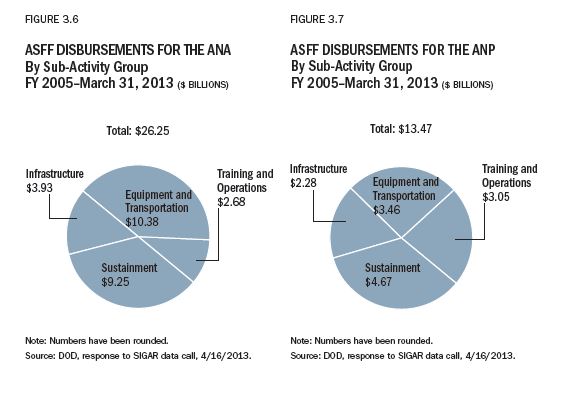SIGAR Finds Huge Problems With $300 Million Afghan National Police Payroll
SIGAR, the Special Inspector General for Afghanistan Reconstruction, has released a report (pdf) describing very disturbing problems with salaries for the Afghan National Police. The report concludes:
The U.S. government is spending more than $300 million annually for ANP salaries with little assurance that these funds are going to active police personnel or that the amounts paid are correct. ANP identification cards with unique numbers are the primary control mechanism to help protect against fraud and abuse, but they are not being used properly—including for attendance and payroll purposes—and there are almost twice as many cards in circulation as there are active police personnel. Further, after 9 years of effort, an electronic human resources system—critical for ensuring the proper personnel are being paid and paid the correct amount—has still not been successfully implemented. Despite lengthy and costly U.S. government attempts to implement this system, AHRIMS, and a payroll system, EPS, the two systems are still not integrated. This lack of integration serves to negate critical controls, such as the ability to reconcile personnel between systems, that should be in place to protect U.S. salary funding from waste and abuse. It is not surprising, therefore, that reports have disclosed inflated police rosters, payments being made to more police personnel than are authorized in particular locations, and police personnel receiving inflated salaries. Achieving full functionality and integration of these systems would only partially resolve existing problems. Such improvements would still not address concerns about low-level ANP attendance procedures or the integrity of the data once it leaves EPS for final salary payment calculations. Also of concern is the payment of ANP personnel in cash via trusted agents, as there are even fewer controls over these salary payments. The fact that as much as half of these payments are possibly diverted from intended recipients is alarming.
The U.S. government and international community plan to continue funding ANP salaries. Some requirements to help safeguard U.S. funds are in place, but neither CSTC-A nor UNDP are fully following them. U.S. Forces-Afghanistan (USFOR-A) should enforce these requirements and—where there are accountability gaps—create new, binding procedures to better safeguard funds. USFOR-A, UNDP, and the MOI must do a better job of coordinating to ensure that ANP personnel numbers match on-the-ground realities and that their salaries are accurate and provided only to actively serving Afghan forces.
We learn from the report that the flawed ANP identification card program was developed by DynCorp, but I don’t see in the report where the equally flawed AHRIMS and EPS programs came from. The fact that after 9 years of trying, we still don’t have a basic system for “taking attendance” for ANP personnel on the job is staggering. As a result, the system is still rife for corruption at all levels as ghost employees can be put on the roles and their salary embezzled. Here is more detail on the corruption enabled by part of the payroll being disbursed in cash:
SIGAR found that nearly 20 percent of ANP personnel are at risk of not receiving their full salaries because they are paid in cash by an MOI-appointed trusted agent, a process that lacks documentation and accountability. CSTC-A and UNDP officials told SIGAR that there is limited oversight of trusted agents and a higher risk that funds may be subject to corruption. Further, CSTC-A reported that corrupt practices within the trusted agent system of salary payments “could take as much as 50 [percent] of a policeman’s salary.”
On a separate but highly related front, Afghanistan finally has announced the full roster of nominees for its cabinet. This move will fill 27 positions. Conveniently, TOLONews has broken those nominees down by where they came from. Thirteen were nominated by Ashraf Ghani and twelve by Abdullah Abdullah. Two are “neutral”, the head of security (who carries over from the previous government) and the head of the banking system.
Returning to the problems in the SIGAR report, ANP falls under the Ministry of the Interior, whose new leader, nominated by Abdullah Abdullah, will be Noor-ul-haq Ulumi. He is a former general as well as having served in the lower house of Afghanistan’s Parliament. He will face quite a challenge in implementing the changes that SIGAR suggests in its report.


